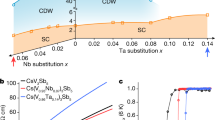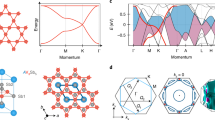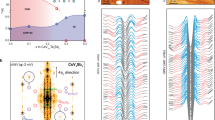Abstract
Determining the types of superconducting order in quantum materials is a challenge. This is especially true when several degrees of freedom contribute to the fermiology and when superconductivity competes with other symmetry-breaking orders. One example is the kagome-lattice superconductor CsV3Sb5, in which multiband superconductivity coexists with a charge order that substantially reduces the space group symmetries of the compound. Here we demonstrate the presence of two superconducting regimes in CsV3Sb5 that are characterized by distinct transport and thermodynamic properties. Our results reveal a substantial quasiparticle weight in a high-temperature regime. At lower temperatures, this weight is removed through the formation of a second gap. We argue that the band with a gap opening at lower temperatures continues to host low-energy quasiparticles, possibly due to the nodal structure of the gap. Taken together, our results present evidence for band-selective superconductivity with uncoupled superconducting gaps.
This is a preview of subscription content, access via your institution
Access options
Access Nature and 54 other Nature Portfolio journals
Get Nature+, our best-value online-access subscription
$32.99 / 30 days
cancel any time
Subscribe to this journal
Receive 12 print issues and online access
$259.00 per year
only $21.58 per issue
Buy this article
- Purchase on SpringerLink
- Instant access to full article PDF
Prices may be subject to local taxes which are calculated during checkout




Similar content being viewed by others
Data availability
All data needed to evaluate the conclusions in the paper are present in the paper. Additional data are available from the corresponding authors upon reasonable request. Source data are provided with this paper.
References
Hunte, F. et al. Two-band superconductivity in LaFeAsO0.89F0.11 at very high magnetic fields. Nature 453, 903–905 (2008).
Yuan, H. Q. et al. Nearly isotropic superconductivity in (Ba,K)Fe2As2. Nature 457, 565–568 (2009).
Prozorov, R. & Kogan, V. G. London penetration depth in iron-based superconductors. Rep. Prog. Phys. 74, 124505 (2011).
Mu, G. et al. Low temperature specific heat of the hole-doped Ba0.6K0.4Fe2As2 single crystals. Phys. Rev. B 79, 174501 (2009).
Fisher, R. A. et al. Specific heat of Mg11B2. Phys. C: Supercond. 385, 180–191 (2003).
Ortiz, B. R. et al. New kagome prototype materials: discovery of KV3Sb5, RbV3Sb5, and CsV3Sb5. Phys. Rev. Mater. 3, 094407 (2019).
Ortiz, B. R. et al. CsV3Sb5: a Z2 topological kagome metal with a superconducting ground state. Phys. Rev. Lett. 125, 247002 (2020).
Khasanov, R. et al. Time-reversal symmetry broken by charge order in CsV3Sb5. Phys. Rev. Res. 4, 023244 (2022).
Shan, Z. et al. Muon spin relaxation study of the layered kagome superconductor CsV3Sb5. Phys. Rev. Res. 4, 033145 (2022).
Mu, C. et al. S-wave superconductivity in kagome metal CsV3Sb5 revealed by 121/123Sb NQR and 51V NMR measurements. Chin. Phys. Lett. 38, 077402 (2021).
Duan, W. et al. Nodeless superconductivity in the kagome metal CsV3Sb5. Sci. China Phys. Mech. Astron. 64, 107462 (2021).
Gupta, R. et al. Microscopic evidence for anisotropic multigap superconductivity in the CsV3Sb5 kagome superconductor. npj Quantum Mater. 7, 49 (2022).
Chen, H. et al. Roton pair density wave in a strong-coupling kagome superconductor. Nature 599, 222–228 (2021).
Xu, H.-S. et al. Multiband superconductivity with sign-preserving order parameter in kagome superconductor CsV3Sb5. Phys. Rev. Lett. 127, 187004 (2021).
Deng, H. et al. Chiral kagome superconductivity modulations with residual Fermi arcs. Nature 632, 775–781 (2024).
Xiang, Y. et al. Twofold symmetry of c-axis resistivity in topological kagome superconductor CsV3Sb5 with in-plane rotating magnetic field. Nat. Commun. 12, 6727 (2021).
Nie, L. et al. Charge-density-wave-driven electronic nematicity in a kagome superconductor. Nature 604, 59–64 (2022).
Zhong, Y. et al. Nodeless electron pairing in CsV3Sb5-derived kagome superconductors. Nature 617, 488–492 (2023).
Guguchia, Z. et al. Tunable unconventional kagome superconductivity in charge ordered RbV3Sb5 and KV3Sb5. Nat. Commun. 14, 153 (2023).
Wu, X. et al. Nature of unconventional pairing in the kagome superconductors AV3Sb5 (A = K, Rb, Cs). Phys. Rev. Lett. 127, 177001 (2021).
Tazai, R., Yamakawa, Y., Onari, S. & Kontani, H. Mechanism of exotic density-wave and beyond-Migdal unconventional superconductivity in kagome metal AV3Sb5 (A = K, Rb, Cs). Sci. Adv. 8, eabl4108 (2022).
Lou, R. et al. Charge-density-wave-induced peak-dip-hump structure and the multiband superconductivity in a kagome superconductor CsV3Sb5. Phys. Rev. Lett. 128, 036402 (2022).
Ritz et al. Superconductivity from orbital-selective electron-phonon coupling in AV3Sb5. Phys. Rev. B 108, L100510 (2023).
Sprau, P. O. et al. Discovery of orbital-selective Cooper pairing in FeSe. Science 357, 75 (2017).
Tinkham, M. Introduction to Superconductivity 2nd edn (McGraw-Hill, 1996).
Hess, H. F. et al. Scanning-tunneling-microscope observation of the Abrikosov flux lattice and the density of states near and inside a fluxoid. Phys. Rev. Lett. 62, 214–216 (1989).
Chandrasekhar, B. S. A note on the maximum critical field of high-field superconductors. Appl. Phys. Lett. 1, 7–8 (1962).
Clogston, A. M. Upper limit for critical field in hard superconductors. Phys. Rev. Lett. 9, 266–267 (1962).
Lu, J. M. et al. Evidence for two-dimensional Ising superconductivity in gated MoS2. Science 350, 1353–1357 (2015).
Saito, Y. et al. Superconductivity protected by spin–valley locking in ion-gated MoS2. Nat. Phys. 12, 144–149 (2016).
Xi, X. et al. Ising pairing in superconducting NbSe2 atomic layers. Nat. Phys. 12, 139–143 (2016).
Zhang, Q. et al. Ultrahigh supercurrent density in a two-dimensional topological material. Phys. Rev. Mater. 7, L071801 (2023).
Cao, Y. et al. Pauli-limit violation and re-entrant superconductivity in moiré graphene. Nature 595, 526–531 (2021).
Ni, S. et al. Anisotropic superconducting properties of kagome metal CsV3Sb5. Chin. Phys. Lett. 38, 057403 (2021).
Khim, S. et al. Field-induced transition within the superconducting state of CeRh2As2. Science 373, 1012 (2021).
Wan, P. et al. Orbital Fulde–Ferrell–Larkin–Ovchinnikov state in an Ising superconductor. Nature 619, 46 (2023).
Klemm, R. A., Luther, A. & Beasley, M. R. Theory of the upper critical field in layered superconductors. Phys. Rev. B 12, 877 (1975).
Bouquet, F. et al. Phenomenological two-gap model for the specific heat of MgB2. Europhys. Lett. 56, 856 (2001).
Gurevich, A. et al. Very high upper critical fields in MgB2 produced by selective tuning of impurity scattering. Supercond. Sci. Technol. 17, 278 (2004).
Matsuda, Y., Izawa, K. & Vekhter, I. Nodal structure of unconventional superconductors probed by angle resolved thermal transport measurements. J. Phys.: Condens. Matter 18, R705 (2006).
Volovik, G. E. Superconductivity with lines of GAP nodes: density of states in the vortex. JETP Lett. 58, 469 (1993).
Kubert, C. & Hirschfeld, P. J. Vortex contribution to specific heat of dirty d-wave superconductors: breakdown of scaling. Solid State Commun. 105, 459 (1998).
Aubin, H., Behnia, K., Ribault, M., Gagnon, R. & Taillefer, L. Angular position of nodes in the superconducting gap of YBCO. Phys. Rev. Lett. 78, 2624 (1997).
Suderow, H., Aubin, H., Behnia, K. & Huxley, A. Quasi-particle vortex scattering in UPt3. Phys. Lett. A 234, 64–68 (1997).
Izawa, K. et al. Superconducting gap structure of spin-triplet superconductor Sr2RuO4 studied by thermal conductivity. Phys. Rev. Lett. 86, 2653 (2001).
Shakeripour, H., Petrovic, C. & Taillefer, L. Heat transport as a probe of superconducting gap structure. New J. Phys. 11, 055065 (2009).
Mielke, C. III et al. Time-reversal symmetry-breaking charge order in a kagome superconductor. Nature 602, 245–250 (2022).
Guo, C. et al. Switchable chiral transport in charge-ordered kagome metal CsV3Sb5. Nature 611, 461–466 (2022).
Roppongi, M. et al. Bulk evidence of anisotropic s-wave pairing with no sign change in the kagome superconductor CsV3Sb5. Nat. Commun. 14, 667 (2023).
Wang, Z. et al. Electronic nature of chiral charge order in the kagome superconductor CsV3Sb5. Phys. Rev. B 104, 075148 (2021).
Telford, E. J. et al. Coupling between magnetic order and charge transport in a two-dimensional magnetic semiconductor. Nat. Mater. 21, 754–760 (2022).
Bing, D. et al. Optical contrast for identifying the thickness of two-dimensional materials. Opt. Commun. 406, 128–138 (2018).
Gurevich, A. Upper critical field and the Fulde–Ferrel–Larkin–Ovchinnikov transition in multiband superconductors. Phys. Rev. B 82, 184504 (2010).
Prozorov, R. & Kogan, V. G. Effective demagnetizing factors of diamagnetic samples of various shapes. Phys. Rev. Appl. 10, 014030 (2018).
Aharoni, A. Demagnetizing factors for rectangular ferromagnetic prisms. J. Appl. Phys. 83, 3432 (1998).
Tagliati, S., Krasnov, V. M. & Rydh, A. Differential membrane-based nanocalorimeter for high-resolution measurements of low-temperature specific heat. Rev. Sci. Instrum. 83, 055107 (2012).
Acknowledgements
M.Z.H.’s group acknowledges primary support from the US Department of Energy, Office of Science, National Quantum Information Science Research Centers, the Quantum Science Center (at ORNL) and Princeton University; STM and transport instrumentation support from the Gordon and Betty Moore Foundation (Grant No. GBMF9461); and support from the US DOE under the Basic Energy Sciences programme (Grant No. DOE/BES DE-FG-02-05ER46200) for the theoretical work and sample characterization, including ARPES. M.Z.H. acknowledges partial support from the US DOE under the Basic Energy Sciences programme (grant number DOE/BES DE-FG-02-05ER46200) for the sample characterization based on advanced spectroscopy work. Sample growth was supported by the National Key Research and Development Program of China (Grant Nos. 2020YFA0308800 and 2022YFA1403400), the National Science Foundation of China (Grant No. 92065109) and the Beijing Natural Science Foundation (Grant Nos Z210006 and Z190006). Z.W. thanks the Analysis and Testing Center at BIT for assistance with facility support. L.B. is supported by DOE-BES (Award DE-SC0002613). The National High Magnetic Field Laboratory (NHMFL) acknowledges support from the US-NSF Cooperative agreement (Grant No. DMR-DMR-2128556) and the state of Florida. We thank T. Murphy, G. Jones, L. Jiao, D. Graf and R. Nowell at NHMFL for technical support. B.L. and M.H.F. are supported by the Swiss National Science Foundation (SNSF) through Division II (number 207908). B.L. additionally acknowledges funding from the Forschungskredit of the University of Zurich (Grant Nr. FK-24-090).
Author information
Authors and Affiliations
Contributions
The electrical transport experiments were performed by M.S.H. and Q.Z. The thermal transport work was performed by E.S.C., M.S.H. and Q.Z. The heat capacity measurements were performed by D.R. in consultation with A.F.B. and L.B. Crystals were grown by Y.L., J.L., Z.W. and Y.Y. The theoretical calculations were performed by B.L., M.H.F. and T.N. Figure development and writing of the paper were undertaken by M.S.H., L.B., M.H.F., T.N. and M.Z.H. M.Z.H. supervised the project. All authors discussed the results, interpretation and conclusion.
Corresponding authors
Ethics declarations
Competing interests
The authors declare no competing interests.
Peer review
Peer review information
Nature Physics thanks Hiroshi Kontani and the other, anonymous, reviewer(s) for their contribution to the peer review of this work.
Additional information
Publisher’s note Springer Nature remains neutral with regard to jurisdictional claims in published maps and institutional affiliations.
Supplementary information
Supplementary Information
Supplementary Sections I–IX and Figs. 1–15.
Source data
Source Data Fig. 1
Source data.
Source Data Fig. 2
Source data.
Source Data Fig. 3
Source data.
Source Data Fig. 4
Source data.
Rights and permissions
Springer Nature or its licensor (e.g. a society or other partner) holds exclusive rights to this article under a publishing agreement with the author(s) or other rightsholder(s); author self-archiving of the accepted manuscript version of this article is solely governed by the terms of such publishing agreement and applicable law.
About this article
Cite this article
Hossain, M.S., Zhang, Q., Choi, E.S. et al. Unconventional gapping behaviour in a kagome superconductor. Nat. Phys. 21, 556–563 (2025). https://doi.org/10.1038/s41567-024-02770-z
Received:
Accepted:
Published:
Issue date:
DOI: https://doi.org/10.1038/s41567-024-02770-z



